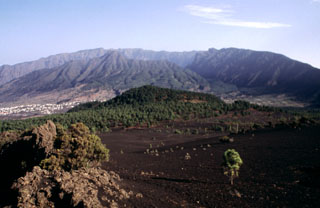Report on La Palma (Spain) — 6 October-12 October 2021
Smithsonian Institution / US Geological Survey
Weekly Volcanic Activity Report, 6 October-12 October 2021
Managing Editor: Sally Sennert.
Please cite this report as:
Global Volcanism Program, 2021. Report on La Palma (Spain) (Sennert, S, ed.). Weekly Volcanic Activity Report, 6 October-12 October 2021. Smithsonian Institution and US Geological Survey.
La Palma
Spain
28.57°N, 17.83°W; summit elev. 2426 m
All times are local (unless otherwise noted)
The eruption at La Palma continued during 6-12 October, characterized by Strombolian explosions, lava fountaining from multiple vents, advancing and branching lava flows, and daily ash emissions. Eruption details are based on official sources including PEVOLCA (Plan de Emergencias Volcánicas de Canarias) steering committee summaries. Seismicity continued to be elevated with most earthquakes located 10-15 km deep (though some deeper than 35 km) in the same area where the swarm first began on 11 September; dozens of events were felt by local residents and some were felt across the entire island.
The largest earthquake, at 0816 on 12 October, was a M 4.1 at a depth of 37 km. Sulfur dioxide emissions fluctuated at high levels between 4,522 and 21,868 tons per day. Sulfur dioxide plumes drifted in multiple directions; on 8 October they reached the Caribbean and on 12 October plumes were over northern Africa, Spain, and Portugal. The main cone had at least three effusive vents and another vent to the N was also active. Multiple collapses of parts of the cone sometimes sent large blocks of cooler lava rafting down the flows. The lava delta was fed by numerous streams of lava during most of the week. Plumes of steam containing hydrochloric acid rose from the edge of the lava delta and were quickly dissipated by the wind; local resident were not affected.
On 6 October a breakout lava flow from the W end of the main flow field traveled S between Los Guirres and El Charcó (previously evacuated), destroying crops and buildings. The flow covered about 0.4 square kilometers and was about 350 m from the coast. Ash plumes rose 3-3.2 km (10,000-10,500 ft) a.s.l. during 6-7 October. On 8 October a new vent formed on the main cone and ash plumes rose as high as 3.5 km (11,500 ft) a.s.l. Ash accumulation at the La Palma and Tenerife North (on Tenerife Island) airports caused a temporary shutdown of operations until the ash was removed. On 9 October a collapse of the N part of the cone sent a wide, multi-lobed flow carrying larger blocks NW over older flows that quickly advanced W along the N margins of the flow field, covering crops and destroying buildings in both Todoque and an industrial area. Ash plumes continued to rise from the vents; lightning was visible in the plume at times.
By 10 October the flow field was 1,520 m wide, and covered 4.9-5.7 square kilometers, depending on the source of the estimates. Between 726 and 1,323 buildings had been engulfed by lava and more than 1.3 square kilometers of crops were lost. About 6,000 people had been evacuated. A partial collapse of the cone allowed the inner lava lake to spill out, sending flows and very large cooled blocks downslope. Ash plumes rose 3.5 km a.s.l. and caused ashfall to the S. Video showed lava fountains rising 500 m above the vent late that night. By 11 October the lava delta had grown mainly to the N and S, and was an estimated 0.34 square kilometers in size, though flows feeding it had slowed. Dense dark ash plumes were seen rising from the main vents. The most northern flow had continued to advance and was 300 m from the coast. The flows overtook a concrete plant, prompting authorities to instruct residents in El Paso and Los Llanos de Aridane to remain indoors and take measures to reduce exposure to toxic fumes. On 12 October the advancing northern flow caused the pre-emptive evacuation of the La Laguna area, totaling 700-800 people. The flow continued to cover crops and was 200 m from the coast, but had slowed. The lockdown for El Paso and Los Llanos de Aridane was lifted after air quality improved. Ash plumes from the main vent rose 3.5 km a.s.l. The Alert Level remained at Red (the highest level on a four-color scale) for affected communities.
Geological Summary. The 47-km-long wedge-shaped island of La Palma, the NW-most of the Canary Islands, is composed of two large volcanic centers. The older northern one is cut by the steep-walled Caldera Taburiente, one of several massive collapse scarps produced by edifice failure to the SW. On the south, the younger Cumbre Vieja volcano is one of the most active in the Canaries. The elongated volcano dates back to about 125,000 years ago and is oriented N-S. Eruptions during the past 7,000 years have formed abundant cinder cones and craters along the axis, producing fissure-fed lava flows that descend steeply to the sea. Eruptions recorded since the 15th century have produced mild explosive activity and lava flows that damaged populated areas. The southern tip of the island is mantled by a broad lava field emplaced during the 1677-1678 eruption. Lava flows also reached the sea in 1585, 1646, 1712, 1949, 1971, and 2021.
Sources: Instituto Volcanológico de Canarias (INVOLCAN), Instituto Geográfico Nacional (IGN), Gobierno de Canaries, Advanced geospatial Data Management Platform (ADAM), Asociación Volcanes de Canarias, Instituto Geológico y Minero de España (IGME), Aena, 1-1-2 Canarias

